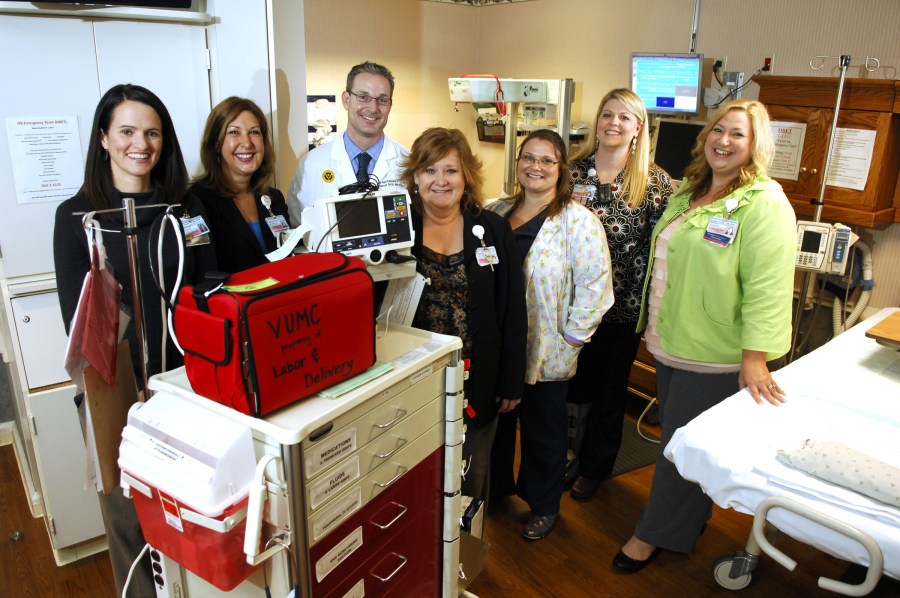
Members of the Postpartum Hemorrhage Taskforce and OB Simulation Team include, from left, Robin Seaton, MSN, R.N., Nicole Herndon, MSN, R.N., Dennis McWeeney, D.O., Kim Domaradzki, R.N.,BSN, Michelle Browning, MSN, Blair Anderson, R.N., and Anisha Fuller, R.N., BSN. (photo by Anne Rayner)
Team approach helps reduce postpartum hemorrhages
Nurses, educators, physicians, residents and pharmacists are working together to reduce postpartum hemorrhages at Vanderbilt University Medical Center, providing higher quality health care to women and illustrating the Magnet culture of Vanderbilt Nursing.
“Our staff nurses suggested we focus more on decreasing postpartum hemorrhage rates, so we pulled a task force together to see what we could improve,“ said Nicole Herndon, MSN, R.N., assistant administrator for the Center for Women’s Health.

In the ensuing months, staff members have been busy addressing this issue from multiple angles and making good on the departmental goal of preventing mild hemorrhages from escalating in severity and requiring transfusions.
It is a big job since the Medical Center is on track to deliver 4,300 babies this fiscal year on a unit comprised of 12 labor and delivery rooms, six maternal special care rooms, two operating rooms and a 32-room postpartum unit.
A key component of the initiative is the “red bag” that includes additional supplies needed in a hemorrhage emergency, such as materials to start IVs, blood tubing and anesthesia supplies. The bag is stocked, positioned atop the crash cart and ready to go.
This new tool, plus the postpartum hemorrhage medication kit, is ready when an emergency arises, providing the staff with more confidence and increasing efficiency since all the supplies are in one, readily accessible place.
“Our team researched best practices, and one of the results was the red bag. We had already found a list of recommended items to be included in a postpartum hemorrhage kit.
“When the staff identified that as a need here, the taskforce was able to say, ‘you would like all the emergency supplies in one easy to reach place? We’ve can do that,’” said Herndon.
But, the red bag alone doesn’t solve all the issues.
Quality consultant Kim Domaradzki , R.N.,BSN, at the Center for Women’s Health, met with physician leaders to discuss implementing a risk factor identification tool from the California Maternal Quality Care Collaborative.
Identifying which population has moderate to high risk helps the entire health care team knows which patients may need additional monitoring and proactive treatment.
Bennett Spetalnick, M.D., assistant professor of Obstetrics and Gyncecology, met with residents to emphasize calling the Obstetrics emergency team early in the process.
Anisha Fuller, R.N., BSN, manager of 4 East Obstetrics, Dennis McWeeney, M.D., medical director of 4 East, nurse educators Robin Seaton, MSN, R.N., and Michelle Browning, MSN, and team came together to provide simulation training to all 125 inpatient OB nurses.
Additional provider and resident training has taken place in the Vanderbilt Center for Experiential Learning and Assessment lab.
For continual improvement, the department has unannounced postpartum hemorrhage simulation drills on the floor to ensure skills stay sharp and an online education module is coming soon.
Data is being reviewed on an ongoing basis, and staff and faculty seem pleased with the changes so far. Meanwhile, leaders are moving forward to the next step in quality improvements – looking at the appropriate use of blood products.













